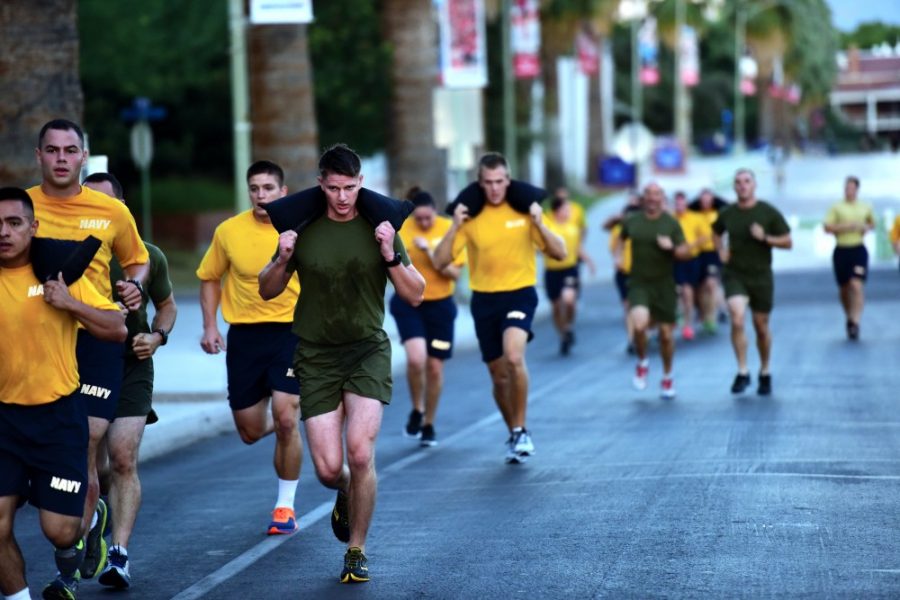It was 5:30 on a Thursday morning—by college standards, the middle of the night. Yet, a strange phenomenon took place outside of Bear Down Gym. The midshipmen of UA’s Navy Reserve Officers Training Corps were assembled, equipped with running shoes and workout gear.
They may have been tired, but the NROTCs didn’t show it as they grinned knowingly at one another. The rest of the world may have the luxury of sleep, but the NROTCs have something more valuable—discipline.
That Thursday morning was physical training. The group of about 142 midshipmen broke into platoons of 30 and headed to different activities. One platoon was doing circuit training on the basketball court next to South Hall.
On a whiteboard read a list of all the activities and reps they had to complete, reminiscent of a CrossFit class. The midshipmen dispersed to different stations and immediately began working out.
They used rowing machines, did pull-ups, squats and triceps dips. One group of four picked up a large log and went for a jog with it lifted above their heads, while another group took turns tethering themselves to weights and sprinting the width of the basketball court.
The routine looked rigorous, but the midshipmen did it with ease. Physical training isn’t to get one into shape; it’s to see how in shape one is. The NROTCs are expected to work out on their own time.
Of the 142 midshipmen, about 40 are Marine options. Their physical training requirements are more rigorous, so they have PT three times a week compared to the normal two.
Marine option Sean Powell, a junior studying history and philosophy, said the hardest thing about the program is “the extra commitments you have to make outside of school.”
General PT is at 5:45 a.m. Monday and Thursday, while extra PT is Tuesday for the underclassmen who are not meeting physical requirements.
Wednesday is uniform day and the midshipmen line up at 6 a.m. in full uniform to be inspected and then briefed in the auditorium for an hour.
Then, from 7-8 a.m., they march on the field working on precision.
Of the four midshipmen interviewed, all were taking 17 to 19 units this semester. Besides classes, many take on leadership roles within the ROTC program, and some, like Cynthia Morton, juggle jobs as well.
Morton, a sophomore studying Arabic and political science with a minor in naval science, said that having extra activities all the time can be stressful, but she has learned to manage her time.
“I’ve never felt like giving up or like this isn’t going to be worth it,” Morton said.
All NROTCs are required to get a minor in naval science. Every semester, they take a three-unit class that ranges in subject matter from introductory naval science to ships, weapons, navigation, the history of the Navy and leadership/management training.
“They’re actually pretty easy courses relative to my other classes, but they’re really interesting. … They’re all taught by our officers, so the officers enhance the course with their past experience,” Morton said.
Each NROTC was drawn to the program for a different reason. Some, like Morton, were involved in junior ROTC programs in high school and have military backgrounds, while others, like sophomore Kaitlin Burleson, were attracted by the full-ride scholarships offered by the NROTC.
For those who qualify for a scholarship, ROTC programs are a great opportunity to get a college degree and then become an officer in the military, which comes with higher pay and respect than what enlisted members receive.
The midshipmen compete nationally for scholarships, contracts and eventually jobs. While many freshmen join the program with scholarships, those who do not have scholarships are allowed to join, but by the end of sophomore year all NROTCs need a scholarship or a contract from the Navy to be able to continue with the program.
Scholarships, contracts and job assignments are awarded based on academics, physical fitness and military aptitude, which includes leadership ability as well as the ability to take orders.
Alessandro Marafino, a geography senior and Marine option, is referred to by the other midshipmen as commander. As commander, Marafino leads the entire company of NROTCs and is looked to for guidance. The student chain of command, he said, is meant to act as a leader for students before they reach the fleet.
There are 15 staff members on active military duty who supervise the NROTC program, but the program is largely student run. One staff member, Lt. Mickey Rhades, said that all the NROTCs here are working toward a commission: appointment by the president.
The NROTCs can apply to several different communities within the Navy—aviation, surface warfare, submarine, special warfare like the Navy Seals or the Marine Corps.
Of the communities, the submarine community requires the most technical skill. According to Col. Wall, head of the UA NROTC program, all midshipmen with the degree program—math, engineering, physics, etc.—and grades—often 3.8 GPA or above—are screened for the nuclear submarine program.
Those who pass the screening are then interviewed by the highest-ranking nuclear officer in the Navy. The officers selected will go on to study nuclear propulsion, as all naval submarines are powered by nuclear reactors.
About 80 percent of the NROTC program is male students, so it can be a little tougher for female students.
“It’s a little harder to earn the respect of people, especially men,” Burleson said.
It may be a lot of work, but the NROTC provides a community for students. When asked to describe her relationship with the other midshipmen, Morton said, “Family. Mostly like brothers. Like having a bunch of goofy brothers that do stupid stuff because it’s mostly guys.”
Follow Michelle Jaquette on Twitter.









